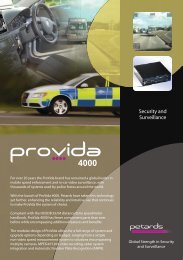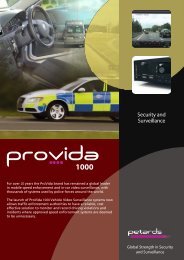eyeTrain Brochure - Petards Group plc
eyeTrain Brochure - Petards Group plc
eyeTrain Brochure - Petards Group plc
You also want an ePaper? Increase the reach of your titles
YUMPU automatically turns print PDFs into web optimized ePapers that Google loves.
On Board Surveillance<br />
Key Components<br />
Facts:<br />
Wide Dynamic Range Pixel-Level Exposure Control<br />
Case Study: ScotRail<br />
When First ScotRail was looking at on-board surveillance<br />
options, they turned to <strong>Petards</strong> to provide the most<br />
sophisticated, reliable and comprehensive security camera<br />
system available.<br />
Up to five state-of-the-art CCTV cameras were installed in<br />
each carriage, capable of recording high-resolution images<br />
from every angle. A total of 2,000 cameras saw almost every<br />
First ScotRail train covered within two years.<br />
Today, the multi-million-pound system remains one of<br />
the most hi-tech on the rail network, with over 230 trains<br />
equipped.<br />
First ScotRail’s entire diesel fleet and almost all its electric<br />
trains were covered in the project.<br />
<strong>Petards</strong> can offer a camera with an advanced exposure<br />
control system, which handles the light in the scene in<br />
much the same way as the human eye. This means that<br />
there are fewer areas where the image is either under- or<br />
over-exposed.<br />
The above comparative images show the exposure<br />
improvements with PIXIM image sensors. Contrast<br />
problems with traditional cameras are experienced where<br />
the items of interest are illuminated with greatly different<br />
amounts of light.<br />
The images on the left are from an <strong>eyeTrain</strong> pixel-level<br />
exposure camera, it can be seen that there is good contrast<br />
in all areas such that you can view detail in both the bright<br />
and dark areas.<br />
Andy Mellors, Engineering Director at First <strong>Group</strong> said: “It is<br />
essential the travelling public can feel confident and secure.<br />
We were impressed with the high-quality images from the<br />
new digital technology.”<br />
Following on from this project, <strong>Petards</strong> again worked<br />
successfully with First <strong>Group</strong>.<br />
This time on the Great Western line, where <strong>eyeTrain</strong> Onboard<br />
was fitted to the full fleet of DMU’s.<br />
Feedback from this second project has again been glowing<br />
with British Transport Police delighted with the evidence<br />
the system has provided, particularly due to the clarity of<br />
image that <strong>eyeTrain</strong> provides.<br />
The combination of internal and external light sources<br />
and the rapidly changing position of a vehicle provide an<br />
environment of adverse lighting conditions.<br />
While the human eye can rapidly adjust to widely differing<br />
light levels, normal video cameras cannot cope with large<br />
light differences simply because they have a limited range<br />
of contrast.<br />
In order to expose the inside of the vehicle in the images<br />
above, a conventional camera (images on the right)<br />
overexposed the outside view, the consequence is that the<br />
outside view has ‘saturated’ highlights – there is no detail in<br />
the very bright areas. If the same camera had exposed the<br />
outside view correctly, the inside of the vehicle would have<br />
been rendered very dark; this time there would have been<br />
no detail in the very dark areas.















